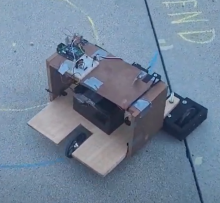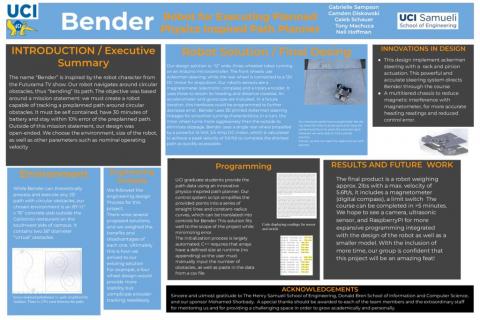Bender ~ The Robot for Executing Physics Inspired Path Planner
Goal and Objectives
This open-ended project involves creating a robot, utilizing all steps of the engineering design process, to autonomously navigate around obstacles while following the shortest path. This project will be in conjunction with UCI graduate students developing a physics-inspired pathfinding algorithm, which we will utilize in our design in order to navigate an obstacle course. Our goal is to design and build a robot capable of: tracking a preplanned collision-free path in a 2D environment containing circular obstacles with a maximum error of 10% at any point, be able to pass through any two closely spaced obstacles and perform turn maneuvers without drifting off-course, when the path planner commands it to, and be self-contained and self-sufficient (no plug ins) and capable of running for at least 30 mins without recharge. As students in achieving the design project goal, we would have practiced all phases of the design process, developed technical skills and critical thinking to quantify the mission statement.
Background
The project description is as follows: “Available literature contains several path planning schemes in which a vehicle is to reach a target point avoiding potential obstacles. Some of these path planners optimize a certain quantity e.g., the distance to the target. All these techniques can be considered to fall under a finite dimension optimization where an optimum path is formed by discretized optimal points. The novel path planner introduced here uses the principle of least action and Calculus of Variations to directly form the optimum path as a function. The students should design the path planner and design and build a robot capable of executing the required control inputs dictated by the path planning scheme. In this OFFLINE phase meant as a proof of concept, an obstacle-oriented map of the environment is formed prior to motion and the control inputs are then given to the robot to accurately execute the path planner commands.”
Technical Details
Due to the nature of the pathfinding algorithm and circular obstacles, the shortest path between two points in the course will always be some combination of straight lines and fixed-radius curves tangent to these lines. We use these properties to our advantage when programming the robot. The robot will use a magnetometer and a reed switch to determine the relative orientation and linear distance traveled. Distinct control equations can be applied in the different “sections” of the course. In a straightaway section, a PID controller can be used adjust for errors between the expected magnetometer bearing and the actual value. After a turn is completed, the expected magnetometer bearing can also be compared with the received value.
Team Contacts
Cam Diskowski - cdiskows@uci.edu
Gabrielle Sampson - gsampson@uci.edu
Neil Hoffmann - nthoffma@uci.edu
Caleb Schauer - schauerc@uci.edu
Tony Machuca - aimachu1@uci.edu
Sponsor/Advisor
Shorbagy Mohamed - mohamem2@uci.edu


